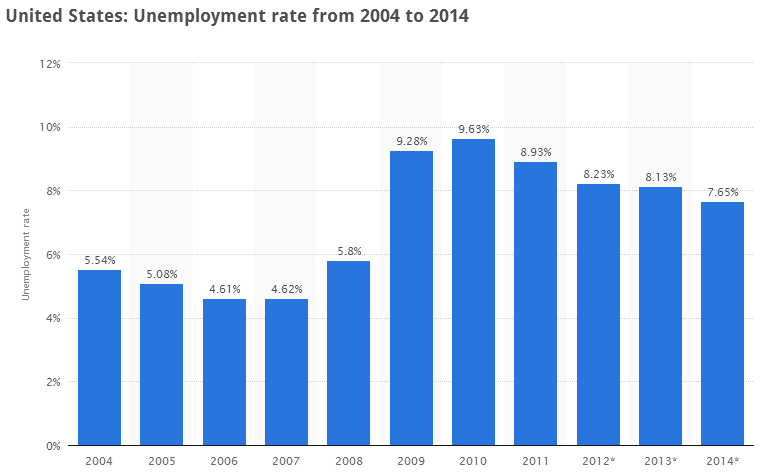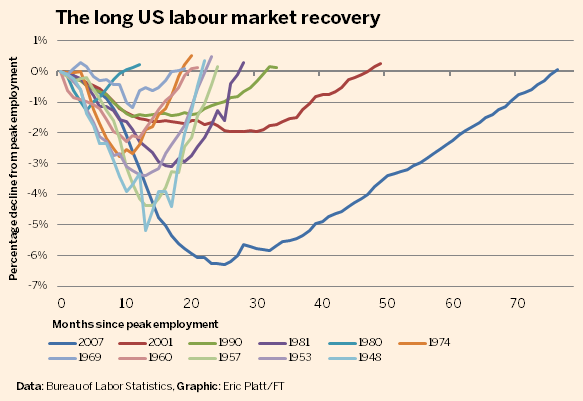- Introduction: Unemployment Rates Remain Dangerously High
- Major Cause: Increasing Deficiency in the Number of Jobs
- Leading Second Cause: Downward Revisions
- Other Reasons: Long-Term Unemployment and Part-Time Jobs
- Vacancies Deficiency and Its Impact on Economy
- People and the Lack of Vacancies: Spurring Competition
- Reference List
Introduction: Unemployment Rates Remain Dangerously High
Despite a rapid increase of SMEs and large entrepreneurships evolution enhanced by the globalization process and the opportunities that it provides, unemployment remains a major issue in a range of states, the USA not being an exception. While the situation regarding unemployment rates is comparatively steady at present, the current rates leave much to be desired. The progress is obvious, yet the economic growth of the state must occur at a faster pace, and the unemployment rates hinder the growth considerably. Though a shrinkage in the number of vacancies and the rapid increase in the number of part-time jobs have had their toll on the unemployment rates, the lack of vacancies still remains the key cause of unemployment in the U.S.

Major Cause: Increasing Deficiency in the Number of Jobs
At present, the people seeking for work in the United States suffer from the lack of vacancies. According to the official data, the U.S. government cut jobs by 13,000 positions in May, 2012 (Rushe, 2012). The specified strategy did not seem to work well for the state’s economy, since the solution, which seemed reasonable two years ago, resulted in a major lack of job opportunities and the unemployment rates hitting 6.2% in 2014 (Rushe, 2014). Even the introduction of 209,000 new jobs in 2014 did not seem to have a tangible effect on the issue: the unemployment rates among certain U.S. demographics, teenagers (20% (Rushe, 2014)) and African American people (11.4% (Rushe, 2014)) in particular. While the specified social strata are affected by unique range of factors, including cultural and social ones, the overall unemployment rate, though admittedly lower than in 2010, still raises a lot of concern.
Leading Second Cause: Downward Revisions
Not only has the number of jobs available ceased to grow, but also experienced a major drop in 2012, which the changes applied to the U.S. economy in 2014 did not affect in the slightest (Rushe, 2014). True, the U.S. economy has admittedly passed its pre-recession peak and is slowly recovering, yet the effects in massive job cuts, which the American population experienced in 2012, are drastic: The specified issue is partially related to the increased competition rates among candidates, which, in its turn, is the result of peaking immigration rates (Harding, 2014).

Other Reasons: Long-Term Unemployment and Part-Time Jobs
Psychologically, long-term unemployment (LTU) is obviously the most depressing factor that keeps unemployment rates rising (Bureau of Labor Statistics, 2014). In 2014, the rates of LTU reached 37.7% and have been growing since (Bureau of Labor Statistics, 2014). Indeed, when being rejected by a range of companies, one is most likely to lose their spirit and abandon the attempts to get a job. This, in its turn, may lead to a major depression. It is remarkable that such depressive attitudes among parents are quickly acquired by their children; as a result, unemployment becomes a family issue.
The abundance of part-time jobs has also contributed to the evolution of unemployment in the U.S. (Rushe, 2012). While often viewed as a reasonable alternative, working part time leads to loss of outstanding professional qualities and becoming a rather mediocre employee, who can hardly become a member of the full-time staff (Rushe, 2012).
Vacancies Deficiency and Its Impact on Economy
As a rule, with a growth in unemployment rates, the money flow process is slackened greatly (Schmidt, 2013). Without the curricular flow of finances, the economy of the state becomes stagnant. Another significant effect of unemployment concerns wealth drainage. Carving money out of the budget to support the unemployed, the government sacrifices a lot of alluring prospects (Schmidt, 2013). Finally, the increase in debts in public spending must be mentioned. The unavailability of funds leads to a major economic recession (Schmidt, 2013).
People and the Lack of Vacancies: Spurring Competition
As it has been stressed above, the unavailability of certain jobs affects people’s personal and professional growth, reducing their self-esteem and depriving them of belief in their success. Naturally, the rates of economic and financial well-being of the people, who are affected by unemployment, drop significantly as well. Unless the measures for terminating unemployment or at least bringing unemployment rates a few notches down are introduced into the affected field, poverty rates are most likely to start rising increasingly.
In search for the jobs that are still available, people affected by unemployment and poverty are likely to resort to illegal means of money-making. The rates of crime peak in the area, where unemployment is an issue, thus, tearing the moral fabric of the community apart. It would be wrong to claim that such crimes are restricted to thefts and armed robberies; even such types of illegal business as drug peddling may possibly emerge, not to mention money laundering and tax dodging (Andersen, 2012).
Reference List
Andersen, S. H. (2012). Unemployment and crime: Experimental evidence of the causal effects of intensified ALMPs on crime rates among unemployed individuals. Odense: University Press of Southern Denmark.
Bureau of Labor Statistics. (2014). Long-term unemployed account for 37.7 percent of all unemployed persons in December 2013. U.S. Department of Labor. Web.
Harding, R. (2014). US employment passes pre-recession peak.Financial Times. Web.
Rushe, D. (2012). US unemployment: six reasons May figures show a troubled recovery.The Guardian. Web.
Rushe, D. (2014). US adds 209,000 jobs in July as unemployment rate rises to 6.2%.The Guardian. Web.
Schmidt, J. (2013). Why does the minimum wage have no discernible effect on employment? Washington, DC: Center for Economic and Policy Research.
The Statistics Portal. (2014). United States: Unemployment rate from 2004 to 2014. Statista: The Statistics Portal. Web.